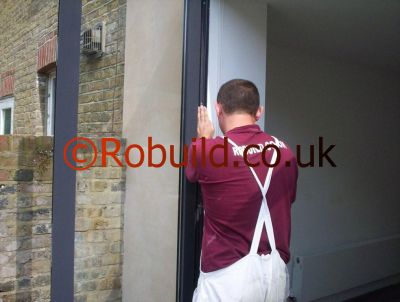Replacing and removing cast iron guttering
Choosing a replacement
Assuming you won’t be using cast iron again – you’ll have a job getting hold of it and even more of a job putting it up, apart from the fact that it’s expensive – your choice is between aluminium and plastic. Plastic guttering is made of UPVC (unplasticised polyvinyl chloride).
It’s probably the better choice for a do-it-yourself installation: it is far more widely available than aluminium, and has the edge in terms of cost and durability. Two different cross-sections are commonly available – half-round and ‘square’.
The latter is often given a decoratively moulded face similar to the more ornate ogee cast iron guttering. In addition, a semi-elliptical guttering is available – it looks a bit like half-round but is deeper and more efficient. This, together with some brands of conventional profile, can be camouflaged by being boxed in with a clip-on fascia panel. Which type you choose is largely a matter of personal taste, but try to choose something that blends into the style of your home.
More important than looks is the size of the gutter. Too small, and it will be forever overflowing; too large, and you will have paid more for the installation than is necessary. It’s all to do with relating the amount of water the guttering can carry to the amount of water likely to come off the roof during a heavy rainstorm. These calculations are complicated, but you can assume that they were done when the guttering was originally installed. Just measure the existing guttering at its widest point to find its size, and buy the same again. The most commonly available sizes are 75mm (3in), 100mm (4in), 112mm (41/2in), 125mm (5in), and 150mm (6in).
If in doubt, consult the manufacturer’s literature or get the London Roofers to do it. The actual cross-section of the gutter may vary from brand to brand; this can make it difficult to join with existing guttering: for example, the guttering belonging to a neighbour on a semi-detached or terraced house. Most firms offer adaptors to link their product with cast iron guttering, or with a different size from within their range.
However, they tend not to offer adaptors to tie in with the equivalent size from another brand, so if possible stick to one brand throughout the installation. If you have to link up with a neighbour’s gutter, find out which brand was used, and try to use the same. There are many different fittings as well as lengths of guttering available on the market. Before you start buying your new guttering get hold of a manufacturer’s brochure from the stockist you use and carefully check to ensure you have all the fittings you will need. Make sure you understand how the particular system works before you buy anything.
Taking down old guttering
Cast iron guttering is heavy, and may also be rusted into place, so removing it can be tricky. But there is no need to be gentle with it: it doesn’t matter if it breaks. The important thing is to work in safe conditions. If you are wrenching things apart, do it in a controlled way so you don’t fall off the ladder, and so that great chunks of gutter don’t fall down. Try not to drop cast iron guttering to the ground: it shatters easily, and, if it lands on a hard surface, dangerous fragments can fly off. If you toss the guttering clear of the house you might overbalance and fall off the ladder, so aim to lower larger sections gently to the ground with a rope. Begin with the section linking gutter and downpipe.
Cut through the old bolts holding the sections together. Then, if you lift the gutter slightly, you should be able to pull it free from the downpipe. Once it’s out of the way, unmake the joints between the sections of gutter (as if you were repairing them), and lift the guttering off its supporting brackets. It may, of course, be screwed directly to the fascia board. You can now turn your attention to the brackets themselves. These are usually screwed to the fascia board just beneath the eaves of the roof, and can either be unscrewed or levered off with a claw hammer. In older houses the brackets may be screwed to the tops or sides of the roof rafters, to support the weight of the iron guttering. If there is a fascia board to which you can fit the new gutter, the ends of the brackets can be hacksawed off. Otherwise, you will have to lift off some of the roofing to remove them. When all the old guttering has been removed, inspect the fascia board to make sure it is sound and securely fixed. If it is, fill the old screw holes and paint it before fixing the new guttering. If it isn’t, it will have to be replaced.



